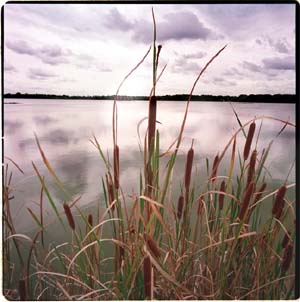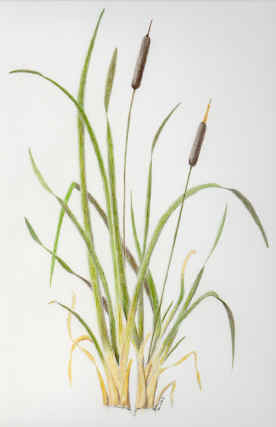|
INTRODUCTION
With several different species and hybrids inhabiting vast ecosystems throughout the world, it is a wonder that cattails are utilized for their potential as infrequently as they are in mainstream economics. Because their robust nature and quick growth rates have earned cattails the nomenclature, “pest,” the contributions they can make to the subsistence world are often forgotten. This versatile plant is woven through the cultural and economic fabrics of history, having survived natural disasters, and thwarting over-harvesting. The ease with which it can be harvested and cultivated, combined with its rapid growth, make it an ideal alternative to threatened NTFPs. This is particularly important under the current circumstances of dwindling resources and exploding populations whose mouths must be fed.
|
|
ECOLOGY
The cattail is a tall marshland perennial, generally reaching 9 – 10 feet in height. Cattails are easily recognizable by their furry, cigar-shaped seed heads that stand upright upon long stalks. Their immature leaves are pointed and sword-like, with parallel veins. Leaves reach their full height of about 10 feet by late spring, during which they protect the stalk in a tight sheath, where the flower head is safely hidden until maturity is reached. The female and male parts of the plant are separated, with the female part resembling a cigar and the male part a narrower, yellowish stalk atop the female part. Once fertilized, the male portion of the plant withers away, while the female part, dense with seeds, remains intact until all the seeds are dispersed in spring (Keator, 1995).
The cattail species common to the Pacific Northwest, Southern cattail (Typha Domingensis) and its cousin, the broadleaf cattail (Typha latifolia), inhabit year-round streams, and the edges of ponds, lakes and freshwater marshes below 5000'. They bloom from June to July |
HISTORY
Historical uses of cattail species are vast and varied. The Cahuilla Indians of California used the stalks for matting, bedding material, and ceremonial bundles. The leaves and sheath were often used for caulking materials. The Apaches used the pollen in female puberty ceremonies. They used the spike as a torch after dipping it in coal oil. The fluff was used as tinder, insulation, and baby beds. The cattail’s versatility also shines in its historical use as a buoyancy tool. Air pockets in the stems made them a perfect material for cordage, used in the construction of tule boats (Murphy, 1959).
As a subsistence resource, cattail species have been a vital resource in Native American life. All parts of the plant are edible if gathered during the appropriate season. The young flower stalks, when taken out of their sheaths, can be boiled or steamed like corn. During the spring, the young shoots can be cut from the rhizomes when it is about 4-16 inches long. The rhizomes themselves are sweet in flavor and can be eaten raw, baked, roasted, or broiled. The base of the stem, initially attached to the rhizomes, can be boiled or roasted like potatoes (Harrington, 1972). Cattail pollen can play an important role in baking, as it can be used as a flour substitute. The pollen’s yellow color also gives foods a decorative yellow tinge. (NRCS).
|
|
ECONOMICS
Cattail species are enjoyed by many as a food source, but currently are not used industrially for food. Perhaps because they are considered such a threat, their full potential as a mass distributed product has not been realized. If utilized, the cattail could have positive impacts on the world’s food supply. One acre of cattails would yield about 6,475 pounds of flour (Harrington 1972), which would consist primarily of about 80% carbohydrates and 6-8% protein. Because of the presence of cattails worldwide, it is an untapped, invaluable resource, currently overlooked by the larger food industry.
MANAGEMENT AND POLICY
Despite their inherent usefulness as a food resource, cattails are often considered noxious pests. If given the proper environment, their robust nature and speedy reproduction rates can pose a serious threat to the biodiversity of their ecosystems. They will invade native plant communities when hydrology, salinity, or fertility change. Therefore, in the presence of cattails, drastically altered wetlands communities face the risk of becoming out-competed, monotypic cattail stands (DCNR).
Current popular strategies for controlling cattail growth can be categorized as physical control, water manipulation, and shade manipulation.
|
|
|
Click Here for cattail recipes!
*Compiled from a paper by Naima Muntal |
|



